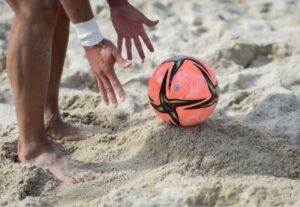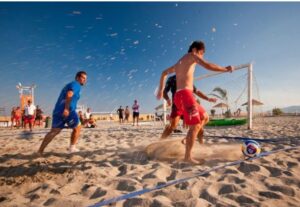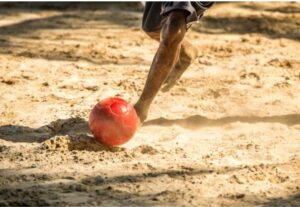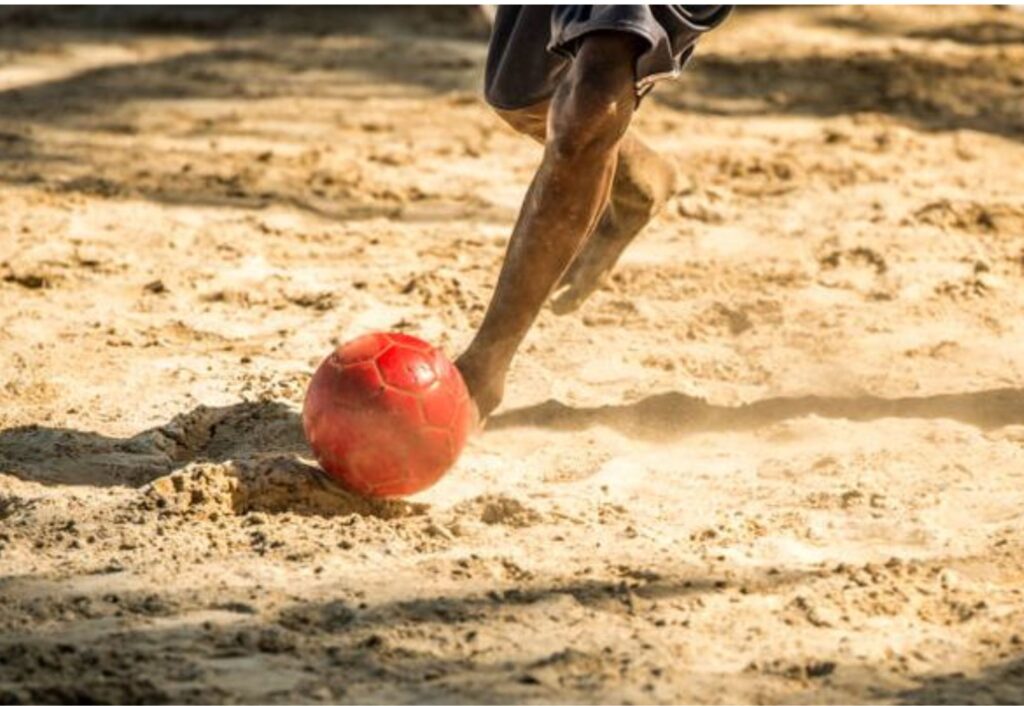Blog
Guide to Playing Football on the Sand Sea
Playing football on a sandy beach is a unique experience that blends the excitement of the sport with the relaxation of the seaside. Whether you’re on vacation or just looking to try something different, beach football offers a fun and challenging way to enjoy the game. In this guide, we’ll cover everything you need to know about playing football on the sand, from setting up the field to mastering the techniques required for this unconventional terrain.
Lin Domain https://javanet247.com/
1. Understanding the Differences: Beach Football vs. Regular Football
Before diving into the specifics, it’s important to understand how beach football differs from traditional football played on grass. The most significant difference is the playing surface. Sand is softer and less stable than grass, which affects your movement, balance, and ball control. Additionally, beach football is typically played with fewer players, smaller goals, and often without shoes.

2. Choosing the Right Equipment
Playing football on the beach doesn’t require much equipment, but the right gear can enhance your experience. Here’s what you’ll need:
- A Beach-Friendly Football: Choose a ball designed for sand play. These balls are usually lighter and more durable to handle the rough surface.
- Comfortable Clothing: Wear lightweight, breathable clothing that allows for ease of movement. Swimwear or sportswear is ideal.
- Optional Footwear: Some players prefer playing barefoot, but if you’re sensitive to hot sand or sharp objects, consider wearing soft beach shoes or sand socks.
- Goalposts: Portable, collapsible goals are perfect for beach football. If you don’t have goals, you can improvise with sticks, cones, or any other markers.
- Water and Sunscreen: Staying hydrated and protected from the sun is crucial when playing on the beach.

3. Setting Up the Field
Beach football fields are typically smaller than standard football fields, and the setup is quite flexible:
- Field Size: A typical beach football field is about 25-35 meters long and 15-25 meters wide. Adjust the size based on the number of players and available space.
- Goal Size: The goals should be smaller than traditional football goals, typically around 3 meters wide and 1.5 meters high.
- Marking the Boundaries: Use cones, sticks, or drawn lines in the sand to mark the field’s boundaries. The sand makes it easy to adjust the field size as needed.
- Team Size: Beach football is usually played with 4-5 players per team, but you can adjust based on the number of participants.
4. Warm-Up and Stretching
Playing on sand requires more effort from your muscles, especially in the legs, so a proper warm-up is essential:
- Dynamic Stretching: Focus on dynamic stretches that target your calves, hamstrings, quadriceps, and hips. These will prepare your muscles for the uneven terrain.
- Short Sprints: Do a few short sprints on the sand to get used to the surface and increase your heart rate.
- Ball Handling Drills: Spend a few minutes dribbling and passing the ball to acclimate to the feel of the sand under your feet.
5. Basic Techniques and Strategies
The sand introduces new challenges, so adapting your playing style is key:
- Movement: Running on sand requires more energy, and it’s harder to maintain balance. Short, quick steps are more effective than long strides. Stay light on your feet and be prepared for sudden shifts in balance.
- Ball Control: Sand makes the ball more unpredictable. Keep the ball close to your feet and use softer touches. Dribbling is more challenging, so focus on short passes and quick movements.
- Passing: Keep your passes low and direct. The sand can slow the ball down, so stronger passes may be necessary.
- Shooting: Shooting on sand requires more power to compensate for the softer surface. Focus on accuracy and aim for the corners of the goal.
- Defense: Defending on sand is about positioning rather than speed. Stay between the opponent and the goal, and use the sand to your advantage by slowing down their movements.
6. Adapting to the Sand: Tips and Tricks
- Use the Terrain: Sand can slow the ball down or cause it to bounce unpredictably. Use this to your advantage by placing the ball in difficult spots for your opponents.
- Stay Hydrated: Playing on sand under the sun can quickly dehydrate you. Take regular water breaks to stay hydrated.
- Mind the Sun: If the sun is directly overhead, it can affect your visibility and energy levels. Consider playing in the early morning or late afternoon when the sun is less intense.
- Barefoot Play: Playing barefoot enhances your connection with the sand and allows for better movement. However, be mindful of the temperature and any debris on the beach.

7. Rules and Variations
Beach football is flexible when it comes to rules. You can modify the game to suit the number of players and the available space:
- Game Duration: Beach football games are typically shorter than regular games, often played in two halves of 10-15 minutes.
- No Offside Rule: Many beach football games do away with the offside rule, making the game more fluid and attacking-focused.
- No Throw-Ins: Instead of throw-ins, restart the game with a kick-in from the sideline.
- Substitutions: Frequent substitutions are common in beach football to keep players fresh, especially given the energy required to play on sand.
8. Playing for Fun and Fitness
Beyond being a fun activity, beach football is also a great workout. The uneven surface works your muscles harder, improving your strength, agility, and endurance. It’s also a fantastic way to socialize, enjoy the outdoors, and combine your love for football with a beach day.
External links https://lawadvisors.pamshion.net/how-do-butterflies-know-ballet.html
Conclusion
Playing football on the beach offers a refreshing twist on the traditional game. The unique challenges of the sandy terrain make it an exciting and demanding activity, perfect for both casual fun and serious training. Whether you’re playing a competitive match or just kicking the ball around with friends, beach football is a great way to enjoy the sport in a beautiful setting. So next time you’re at the beach, set up a game and experience the thrill of football on the sand!

